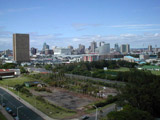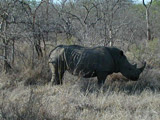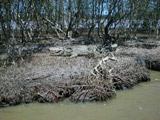


KwaZulu/Natal Area
KwaZulu/Natal area, located 200 Km. to the
north of Durban, is a wonderful region, scattered with 57 parks and
protected areas controlled by the Natal Park Authority. KwaZulu/Natal
represents, due to its 7 different ecosystems, from the bush to the
rain forest or from the beach to the barrier reef, an excellent alternative
or the ideal completition of Kruger Park.
Hluhluwe and Umfolozi form today a single huge park with a total
surface of 960 sq. Km. and they represent the oldest protected areas
(1897) of the country. Umfolozi, once upon a time a hunting reserve
of the Zulu people, became a sad massacre zone of poacher; these last
ones caused a depopulation and only today, thanks to a strong programme
of rescue, mainly concerning the rhinos (dying species), the fauna has
been saved and it started again to increase. These two reserves are
nowadays the sanctuary of the white and black rhinos; but they shelter
the famous "Big Five" (rhino, elephant, buffalo, lion and
leopard) besides giraffes, antelopes, hippos and crocodiles. Very important
is also the Santa Lucia Complex, that spreads out to the boundaries
of St. Lucia Lake where live hippos and crocodiles, besides over 400
different species of birds. Among the most important private reserves,
we remind the Phinda Resourse Reserve that has started off one
of the most important projects of solidarity of all the african continent.
The Phinda Resource Reserve has allowed to a totally destroyed area
to thrive again: today there are many species of animals sheltered in
this area and the consequent turistic investments have involved personally
the popolation that could benefit.
St. Lucia Estuarine System
The St. Lucia Estuarine System is the largest
in Africa fed from the south by the Indian Ocean bringing salty water
in on a tidal basis every 12 hours. It has an average depth of 1,2 m.
The widest point being approximately 21 Km. and the narrowest of 250 m.,
with a total extension of 300 sq. Km.
Being a World Heritage Site, the system supports a wide variety of animal
and plant life, the largest amphibian mammal being the hippopotamus descendent
from the pig family living in harmony with the Nile Crocodile.
The St. Lucia estuarine system is fed from the north by 4 main rivers,
the largest being the Mkuze, Nyalazi, Umzeneni and the Hluhluwe.
The Nile Crocodile: has been around for 180 millions years; it
hasn't changed in the last 18 millions years and has survived the dinosaur
extinction. Males can reach 5,5 m. and females 3,9 m. They are masters
in conserving energy. They can stay submerged for 2 hours slowing down
their heart beat to 4 beats per minute locking off 2 of the 4 chambers
in their heart going into a semi coma like state. A crocodile can live
to approximately 100 years in the wild. In captivity no one has accurately
documented precisely what age it can reach, but as long as it is fed,
they estimate that it can reach 150 years.
At the Crocodile Center outside St. Lucia you find a more understanding
of these animals as it is one of the first in the world with crocodile
studies.
The hippo: It is the most underestimated animal in Africa, responsible
for more deaths than any other animal. A hippo can snap a man in half
with one bite and has 6 tons of pressure per square centimeter, their
weapons being their teeth. The males can reach 2 tons and the females
1,5 tons. They can stay under water for over 6 minutes being totally weightless
in water. They can reach speed of up to 30 Km. in water, and almost 45
Km. on land, so you can't outswim or outrun a hippo. They are nocturnal
herbivores and leave the water at sundown wandering up to approximately
50 Km. looking for grass to eat.

